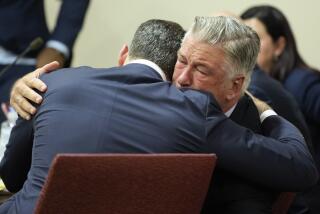New Questions Raised on Simpson Case Glove
- Share via
A criminalist at the O.J. Simpson civil trial testified Wednesday that the bloody left-hand glove booked as crime-scene evidence at the LAPD lab may not be the same one police found near the bodies of Nicole Brown Simpson and Ronald Goldman--raising baffling new questions about the integrity of evidence.
Criminalist Dennis Fung sounded mystified as he compared the extra-large leather glove tagged as evidence to a photo taken in the police crime lab of the glove detectives recovered from the murder scene. The photo appears to depict a rip in the glove over the ring finger--a pebble-sized mark that shows up white against the dark fabric. But the actual glove has no damage on the ring finger and in fact looks relatively unworn.
“I’m not sure this is the same glove,” Fung said, looking in evident bewilderment from the photo to the evidence item in front of him.
“I’m pretty sure it isn’t,” lead defense lawyer Robert C. Baker responded.
With that, the infamous gloves swooped to the center of the Simpson case, once again held up by the defense as a symbol of the alleged conspiracy to frame Simpson for murder.
Baker did not attempt to explain how, when or why someone could have swapped gloves in the LAPD lab. Nor did he comment about whether such tampering might have taken place before or after Simpson’s criminal trial. But he did leave jurors with the clear implication that something was very wrong.
The plaintiffs, apparently taken aback by Fung’s testimony, did not question him in court about the glove; instead they huddled over the photo after jurors were dismissed for lunch.
Sources said the plaintiffs will argue during their rebuttal next week that the imperfection on the photographed glove--which Baker described as a hole that exposed the light-colored cashmere lining--is really just a piece of debris stuck to the leather.
Fung, the criminalist who collected most of the evidence, testified that he found a chip or pebble on one of the gloves--he could not remember which one--and said he packaged it with the gloves as evidence. The plaintiffs plan to show an enlarged version of the photo during their rebuttal case, the sources said, to make the point that the alleged damage mark is probably just a piece of stucco.
For now, however, jurors are left with what one analyst called “the great glove mystery.” Baker seized the moment and made the most of it:
“You would agree that the glove that was booked into evidence and the glove in that photo are not the same glove?” he asked Fung. The judge sustained an objection and Fung, who spent days on the stand during the criminal trial fending off defense attacks on his competence, did not have to answer. Nonetheless, Baker forged on: “Well, the glove didn’t miraculously get the hole repaired, did it, sir?” That question, too, drew an objection. Still, Baker had made his point.
When jurors got a chance to study the gloves up close, they took their time. One by one, they scrutinized them, inside and out, and compared the left and the right hands. One juror even tried them on.
Said Loyola Law School Associate Dean Laurie Levenson, who watched the episode unfold Wednesday: “What was most troubling was that the plaintiffs didn’t have an immediate answer. . . . It makes you worry about the integrity of the evidence.”
If an enlargement of the photo makes it clear that the apparent rip in the fabric is really just debris, she said, jurors might well dismiss the defense as “desperate” to fabricate conspiracies at every turn. But if there is some ambiguity, “That would go a long way toward boosting the defense theory that you can’t trust anything about this case. If you can get into the evidence locker and switch gloves, you can do anything.”
To guard against such tampering, police procedure dictates that anyone who touches a piece of evidence has to sign a log book. Simpson’s defense teams have made much of the deficiencies in such logs, pointing out that several contain inaccurate times, that they fail to include all relevant information, and that they even misstate the locations where some evidence was discovered.
From “time to time,” mistakes do get made, acknowledged Deputy Dist. Atty. Dennis Ferris, who trains both police and prosecutors in correct procedures. “One day in court I opened up the envelope [that] was supposed to [contain] a .45,” Ferris said. “It was garden tools. Either somebody grabbed the wrong envelope or mislabeled it.”
Evidence is generally stored in a guarded locker in the police station until it is needed in court. Once an item is introduced in a trial, court clerks assume custody of it, locking it into a courthouse cabinet.
Prosecutors say they believe the evidence in the Simpson criminal trial remained in the courthouse locker until the civil trial began. With the criminal trial over, they say, they have no need to get involved in the latest controversy over the gloves.
“We’re not involved in the civil trial,” said Sandi Gibbons, a spokeswoman for the district attorney’s office.
Senior LAPD officials were not available for comment.
The gloves are a crucial piece of circumstantial evidence because one was found near the bodies and the other, its apparent mate, was found on Simpson’s estate. Both were smeared with blood, but the only DNA results came from the right-hand glove, which contained genetic markers consistent with both victims and with O.J. Simpson.
In both the civil and criminal trials, defense attorneys have contended former LAPD Det. Mark Fuhrman planted the glove at Simpson’s house. But until Wednesday, no one had raised the possibility that the left-handed glove was not genuine crime scene evidence.
Although the gloves have made periodic appearances in the civil trial, they have not been the centerpiece that they were during Simpson’s criminal trial, when lead defense counsel Johnnie L. Cochran Jr. built his closing argument around the mantra, “If it doesn’t fit, you must acquit.”
Baker did show jurors the famous videotape of Simpson struggling to tug on the gloves and pronouncing them “too tight.” He has also alluded often to the defense theories that police planted blood in Simpson’s Bronco by swiping a glove across the console and then continued the frame-up by dropping the right-handed glove on Simpson’s estate and later daubing Simpson’s blood on it. But without Fuhrman himself to testify--the former detective now lives in Idaho, out of reach of a subpoena--the gloves have not dominated the case.
Wednesday’s episode may bring them back to center stage.
“It’s probably the best moment of the trial for the defense so far,” said Loyola Law Professor Stan Goldman, who watched the testimony unfold.
Pointing out that the left-handed glove looked newer than the torn right-handed one, Goldman said that unless the plaintiffs come up with a very compelling explanation, “jurors are all but honor-bound to conclude” that the evidence was mishandled, by either innocent mistake or deliberate tampering.
Experts in the criminal trial conducted tests on several pairs of Aris Isotoner Leather Light gloves similar to those found at the crime scene and at Simpson’s house. But the glove Fung examined in court had some lab markings on it indicating bloodstains, which would seem to imply that it was not one of the brand-new gloves introduced for comparison’s sake during the criminal trial.
As Levenson pointed out, however, defense lawyers do not need to explain where the glove came from--for their purposes, it’s enough just to raise some mystery about it. And they seem to have done just that, puzzling even one lawyer who had been involved in the criminal case against Simpson.
“I’m baffled. I’m mystified. I have no explanation,” said Gerald Uelman, the Santa Clara law school dean who was a member of Simpson’s vaunted “dream team.”
Times staff writer Alan Abrahamson contributed to this report
* CLARK LEAVING OFFICE: Marcia Clark is leaving the D.A.’s office for a TV talk show. B1
(BEGIN TEXT OF INFOBOX / INFOGRAPHIC)
The Glove Connection
The Discovery: Two bloody leather gloves were entered into evidence in the O.J. Simpson case, the right-hand glove that Det. Mark Fuhrman said he found amid leaves and other debris outside Kato Kaelin’s room on Simpson’s estate and a left-hand glove found near the victims’ bodies.
Previous Testimony: In the criminal trial, prosecution witnesses acknowledged that the left-hand glove did not show any evidence of cuts and speculated that the glove dropped to the ground prior to a struggle in which they claim Simpson’s hand was cut. The gloves have been frozen and unfrozen a number of times while in police custody and during evidence testing.
More to Read
Sign up for Essential California
The most important California stories and recommendations in your inbox every morning.
You may occasionally receive promotional content from the Los Angeles Times.













